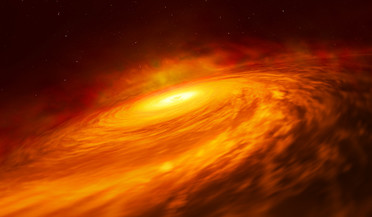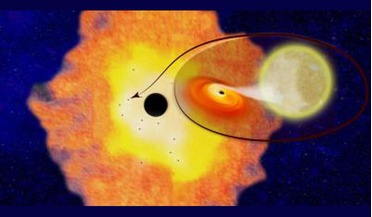ROOM: The Space Journal is one of the leading magazines on space exploration, technology and industry. At ROOM, we share a common dream – advancement of peaceful space exploration for the benefit of humankind, all while bringing you detailed articles on a plethora of contemporary topics. Our authors include analysts and industry leaders from all over the world, which lets us bring you the newest and comprehensive information about hubble space black holes.
 12 July 2019
Hubble uncovers black hole that shouldn't exist
12 July 2019
Hubble uncovers black hole that shouldn't exist
... Hubble Space Telescope have observed an unexpected thin disc of material encircling a supermassive black hole at the heart of the spiral galaxy NGC 3147, located 130 million light-years away. The presence of the black hole ...Chiaberge of AURA for ESA, STScI and Johns Hopkins University. The disc’s material was measured by Hubble to be whirling around the black hole at more than 10% of the speed of light. At such extreme velocities, the gas appears...
 24 March 2017
Gravitational waves expel black hole from galaxy centre
24 March 2017
Gravitational waves expel black hole from galaxy centre
... have detected a rogue black hole weighing more than 1 billion suns, that has been kicked out from its parent galaxy by these ripples in space-time. By using the NASA/ESA Hubble Space Telescope, an international team... of astronomers have found that a quasar, the tell-tall sign of a supermassive black hole, is approximately 35, 000 light...
 26 July 2019
Three massive black holes caught in the act of merging
26 July 2019
Three massive black holes caught in the act of merging
... is short for Active Galactic Nuclei and they are thought to be powered by centrally located supermassive black holes. Not all black holes are monstrous feeding machines. Some, like the one at the centre of our galaxy, are relatively... to 3.26 light years). SDSS J0849+1114 has been observed before, but comprehensive new observations with the Hubble Space telescope, Chandra X-ray, and the Very Large Array (VLA) located in central New Mexico, by a ...
 05 April 2018
Newly discovered black holes suggests thousands more in our galaxy
05 April 2018
Newly discovered black holes suggests thousands more in our galaxy
... Columbia University, helps support a long standing theory that thousands of black holes surround supermassive black holes (SMBHs) at the centre of large galaxies, but with black holes being what they are, it is a theory that up until ...other galaxies. Extensive, but fruitless searches have been made in the past for black holes surrounding Sgr A*, the closest supermassive black hole (SMBH) to Earth and therefore the easiest to study, but so far,...
 02 September 2020
Heaviest black hole merger yet is a first for discoveries
02 September 2020
Heaviest black hole merger yet is a first for discoveries
...with our current understanding of stellar processes. All of the black holes observed to date fit within either of two categories: supermassive black holes, and stellar-mass black holes. The first variety, such as the one at the ...mass range between stellar-mass and supermassive black holes. Along with rapid gas accretion, intermediate-mass black holes have been linked to the formation of supermassive black holes, though so far their existence has ...
 18 January 2021
New study looks at how to harness energy from a black hole
18 January 2021
New study looks at how to harness energy from a black hole
... say the authors. “Thousands or millions of years from now, humanity might be able to survive around a black hole without harnessing energy from stars,” Comisso said. “It is essentially a technological problem. If we look at the... are truly fascinating. We look forward to the potential translation of seemingly esoteric studies of black hole astrophysics into the practical realm." The study, Magnetic reconnection as a mechanism for energy extraction...
 06 May 2016
Accurate mass of supermassive black hole calculated by astronomers using ALMA
06 May 2016
Accurate mass of supermassive black hole calculated by astronomers using ALMA
... for ALMA and has helped constrain the actual mass of the black hole, as previous studies of NGC 1332 with ground- and space-based telescopes have suggested the mass is anywhere between 500 million ...than the Hubble Space Telescope," noted UCI graduate student Benjamin Boizelle, a co-author on the study. "This observation demonstrates a technique that can be applied to many other galaxies to measure the masses of supermassive black holes to ...
 22 March 2017
Massive quasars can be powered by direct collapse black holes say scientists
22 March 2017
Massive quasars can be powered by direct collapse black holes say scientists
...discovered evidence for an unusual kind of black hole born extremely early in the Universe. Termed ‘direct collapse’ black holes (DCBHs), these massive objects start from a "seed" black hole, created when an extremely massive star ...then postulated that perhaps DCBHs helped form another type of perplexing object – supermassive black holes (SMBHs). Supermassive black holes are some of the most important objects in the Universe. Not only do they...
 02 December 2019
"Impossible" black hole found in our Galaxy
02 December 2019
"Impossible" black hole found in our Galaxy
...short of fantastic: a star eight times heavier than the Sun was seen orbiting a 70-solar-mass black hole, every 79 days. The discovery of LB-1 fits nicely with another breakthrough in astrophysics. Recently, ...gravitational wave detectors have begun to catch ripples in spacetime caused by collisions of black holes in distant galaxies. Intriguingly, the black holes involved in such collisions are also much bigger than what was previously considered ...